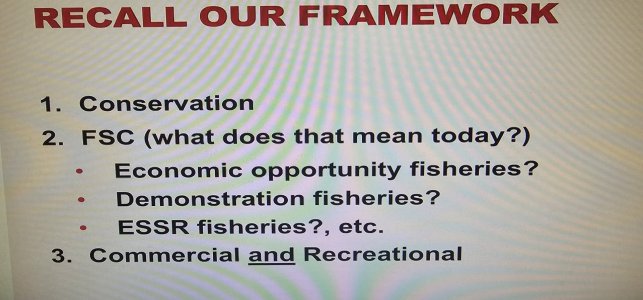OldBlackDog
Well-Known Member
Bob Hooton
13h ·ABOUT THAT SELECTIVE FISHING
Just over five years ago the BC Wildlife Federation sponsored what was expected to be a milestone selective fishing forum in Coquitlam, BC. Interior Fraser Steelhead (IFS) were the primary concern. The entire proceedings were recorded, thus providing an excellent opportunity to examine what an impressive assemblage of speakers put on record and what has transpired since.
The YouTube material covering the March 13, 2019 forum comes in two parts, both available from the BC Wildlife Federation web site. The individual presentations are covered in one part. There’s nine of them that consume almost six hours. That’s obviously more than anyone wants to digest except in small doses. I submit it’s worth doing, though. The presentation by Dr. Eric Taylor, the Chair of the Committee on the Status of Endangered Wildlife in Canada at the time IFS were recommended for listing under Canada’s Species At Risk Act is highly recommended.
https://www.youtube.com/playlist...
The second YouTube piece includes the session introduction by then President of the BCWF, Harvey Andrusak, questions from the audience and summary remarks. It is 50 min in length. It would have been more logical to organize the two pieces such that the introduction preceded the individual presentations but readers will have to bear with the format as is.
https://www.youtube.com/watch?v=vhk3yNjZ6kc...
The summary remarks of particular note were provided by Watershed Watch Executive Director Aaron Hill from 40 minutes onward.
Five years seems a reasonable period to wait before asking the question, how are we doing? Check out the most recent escapement figures below for Thompson and Chilcotin steelhead and decide for yourself.
Harkening back to Dr. Taylor ‘s remarks it ought to be clear what it’s going to take to alter the status quo. No amount of tinkering around the edges of selective fishing with an experimental device here and there, always in addition to the standard nets, rather than in replacement of them will produce a continuing succession of figures identical to the above. If decision makers are ever going to be serious about conservation, particularly in relation to IFS, hard decisions must be made.
Governments at all three levels would have us believe their overriding policy is conservation first. We’ve been told for decades that even First Nations’ food, social and ceremonial fisheries are second to conservation. Nets have no place in waters where fish twice recommended for listing under SARA continue to be harvested. Either rid the waters of them for the entire 81- day run timing window for IFS or stand up and admit publicly those fish don’t count and quit wasting taxpayer dollars on the pretext trends in abundance will be reversed. Above all else, quit pretending a conservation hatchery is the answer and don’t repeat the IFS travesty for the Skeena.

